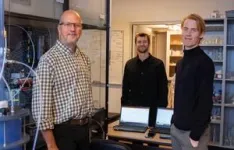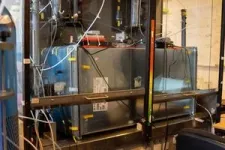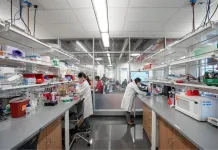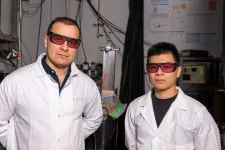(Press-News.org) In a spectacular new study, researchers from the University of Copenhagen have used light and chlorine to eradicate low-concentration methane from air. The result gets us closer to being able to remove greenhouse gases from livestock housing, biogas production plants and wastewater treatment plants to benefit the climate. The research has just been published in the journal Environmental Research Letters.
The Intergovernmental Panel on Climate Change (IPCC) has determined that reducing methane gas emissions will immediately reduce the rise in global temperatures. The gas is up to 85 times more potent of a greenhouse gas than CO2, and more than half of it is emitted by human sources, with cattle and fossil fuel production accounting for the largest share.
A unique new method developed by a research team at the University of Copenhagen’s Department of Chemistry and spin-out company Ambient Carbon has succeeded in removing methane from air.
"A large part of our methane emissions comes from millions of low-concentration point sources like cattle and pig barns. In practice, methane from these sources has been impossible to concentrate into higher levels or remove. But our new result proves that it is possible using the reaction chamber that we’ve have built," says Matthew Stanley Johnson, the UCPH atmospheric chemistry professor who led the study.
Earlier, Johnson presented the research results at COP 28 in Dubai via an online connection and in Washington D.C. at the National Academy of Sciences, which advises the US government on science and technology.
Reactor cleans methane from air
Methane can be burnt off from air if its concentration exceeds 4 percent. But most human-caused emissions are below 0.1 percent and therefore unable to be burned.
To remove methane from air, the researchers built a reaction chamber that, to the uninitiated, looks like an elongated metal box with heaps of hoses and measuring instruments. Inside the box, a chain reaction of chemical compounds takes place, which ends up breaking down the methane and removing a large portion of the gas from air.
"In the scientific study, we’ve proven that our reaction chamber can eliminate 58 percent of methane from air. And, since submitting the study, we have improved our results in the laboratory so that the reaction chamber is now at 88 percent," says Matthew Stanley Johnson.
Chlorine is key to the discovery. Using chlorine and the energy from light, researchers can remove methane from air much more efficiently than the way it happens in the atmosphere, where the process typically takes 10-12 years.
"Methane decomposes at a snail's pace because the gas isn’t especially happy about reacting with other things in the atmosphere. However, we’ve discovered that, with the help of light and chlorine, we can trigger a reaction and break down the methane roughly 100 million times faster than in nature," explains Johnson.
Up next: livestock stalls, wastewater treatment plants and biogas plants
A 40ft shipping container will soon arrive at the Department of Chemistry. When it does, it will become a larger prototype of the reaction chamber that the researchers built in the laboratory. It will be a "methane cleaner" which, in principle, will be able to be connected to the ventilation system in a livestock barn.
"Today’s livestock farms are high-tech facilities where ammonia is already removed from air. As such, removing methane through existing air purification systems is an obvious solution," explains Professor Johnson.
The same applies to biogas and wastewater treatment plants, which are some of the largest human-made sources of methane emissions in Denmark after cattle production.
As a preliminary investigation for this study, the researchers traveled around the country measuring how much methane leaks from cattle stalls, wastewater treatment plants and biogas plants. In several places, the researchers were able to document that a large amount of methane leaks into the atmosphere from these plants.
"For example, Denmark is a pioneer when it comes to producing biogas. But if just a few percent of the methane from this process escapes, it counteracts any climate gains," concludes Johnson.
The research is funded by a grant from Innovation Fund Denmark for the PERMA project, a part of AgriFoodTure. The research was conducted in collaboration between the University of Copenhagen, Aarhus University, Arla, Skov and the UCPH spin-out company Ambient Carbon, started and now headed by Professor Matthew Stanley Johnson. The company was started to develop MEPS (Methane Eradication Photochemical System) technology and make it available to society.
The research has just been published in the journal Environmental Research Letters. https://iopscience.iop.org/article/10.1088/1748-9326/ad0e33
ABOUT THE METHOD
The researchers built a reaction chmaber and devised a method that simulates and greatly accelerates methane's natural degradation process.
They dubbed the method the Methane Eradication Photochemical System (MEPS) and it degrades methane 100 million times faster than in nature.
The method works by introducing chlorine molecules into a reaction chamber with methane gas. The researchers then shine UV light onto the chlorine molecules. The light’s energy causes the molecules to split and form two chlorine atoms.
The chlorine atoms then steal a hydrogen atom from the methane, which then falls apart and decomposes. The chlorine product (hydrochloric acid) is captured and subsequently recycled in the chamber.
The methane turns into carbon dioxide (CO2) and carbon monoxide (CO) and hydrogen (H2) in the same way as the natural process does in the atmosphere.
More about methane (CH4):
Methane can be burned off to remove it from air, but its concentration must be over 4%, 40,000 parts per million (ppm) to be flammable. As most human-caused emissions are below 0.1 percent, they cannot be burned.
The Intergovernmental Panel on Climate Change (IPCC) has determined that reducing methane gas emissions will immediately reduce the rise in global temperatures.
Methane is a greenhouse gas that is emitted naturally from, among other things, wetlands and from man-made sources such as food production, natural gas and sewage treatment plants.
Today, methane gas is responsible for a third of the greenhouse gases that affect the climate and cause global warming.
It takes methane 10-12 years to decompose naturally in the atmosphere, where it is converted into carbon dioxide.
Over a 25-year period, methane is 85 times worse for the climate than CO2. Over a 100-year period, methane is 30 times worse for the climate than CO2.
The concentration of methane in the atmosphere has increased by 150% since the mid-1700s.
Methane alone has increased anthropogenic radiation exposure by 1.19 W/m^2, which is responsible for a 0.6 ◦C increase in global average surface air temperature, according to the IPCC.
Contact:
Matthew Stanley Johnson
Professor
Department of Chemistry
University of Copenhagen
Mobile: +46 706 250 412
msj@chem.ku.dk
Michael Skov Jensen
Journalist and team coordinator
The Faculty of Science
University of Copenhagen
Mobile: + 45 93 56 58 97
msj@science.ku.dk
END
Researchers invent "methane cleaner": Could become a permanent fixture in cattle and pig barns
In a spectacular new study, researchers from the University of Copenhagen have used UV light and chlorine to eradicate low-concentration methane from air. The result gets us closer to being able to remove greenhouse gases from livestock housing
2023-12-18
ELSE PRESS RELEASES FROM THIS DATE:
Algae as a surprising meat alternative and source of environmentally friendly protein
2023-12-18
With more of us looking for alternatives to eating animals, new research has found a surprising environmentally friendly source of protein – algae.
The University of Exeter study has been published in The Journal of Nutrition and is the first of its kind to demonstrate that the ingestion of two of the most commercially available algal species are rich in protein which supports muscle remodeling in young healthy adults. Their findings suggest that algae may be an interesting and sustainable alternative to animal-derived protein with respect to maintaining and building muscle.
Researcher Ino Van Der Heijden ...
Unconventional cancer research consortium created with $3.2M grant from US Department of Defense
2023-12-18
Funding an unconventional approach to fighting cancer that emphasizes the integration of diverse scientific disciplines, the U.S. Department of Defense has awarded $3.2 million to establish the Convergent Science Cancer Consortium (CSCC), led by Dean’s Professor of Biological Sciences Peter Kuhn at the USC Dornsife College of Letters, Arts and Sciences.
The consortium, which includes Stanford University, Cedars-Sinai Medical Center and Children’s Hospital Los Angeles as inaugural members, unites experts from fields such as biology, engineering, mathematics and computer science, to discover more effective treatment strategies ...
Psychedelic psilocybin-assisted therapy reduces depressive symptoms in adults with cancer and depression
2023-12-18
Results from a phase II clinical trial indicate that psilocybin, a hallucinogenic chemical found in certain mushrooms of the genus Psiloybe, may benefit individuals with cancer and major depression. Trial participants treated with psilocybin not only experienced a lessening of depressive symptoms but also spoke highly of the therapy when interviewed at the end of the trial. The findings are published by Wiley in two articles appearing online in CANCER, a peer-reviewed journal of the American Cancer Society.
By binding to a specific subtype of serotonin receptor in the brain, psilocybin can cause alterations to mood, ...
Parents’ top resolutions: More patience, less time on phones
2023-12-18
ANN ARBOR, Mich. – Among many parents’ top resolutions for the New Year: More patience, less time on phones, better consistency with discipline and healthier family habits.
Their tweens and teens are setting goals too – including achievements related to grades and school, success in an activity, exercise and nutrition and earning money, according to the University of Michigan Health C.S. Mott Children’s Hospital National Poll on Children’s Health.
Nearly three in four parents polled report making ...
Few patients receive opioid agonist therapy after opioid overdose, despite benefits
2023-12-18
In the week following any hospital visit for an overdose, only 1 in 18 people with opioid use disorder begin a treatment known to be highly effective in reducing illness and deaths, according to new research in CMAJ (Canadian Medical Association Journal) https://www.cmaj.ca/lookup/doi/10.1503/cmaj.231014.
“These results highlight critical missed opportunities to prevent future mortality and morbidity related to opioid use, despite connection to health care for many patients in the days after a toxicity event,” writes Dr. Tara Gomes, a researcher at ...
Time to move on from ‘doctor knows best’, say experts, as study finds clinicians rank patient views as least important in diagnosis
2023-12-18
Experts today call for more value to be given to patients’ ‘lived experiences’ as a study of over 1,000 patients and clinicians found multiple examples of patient reports being under-valued.
The research, led by a team at the University of Cambridge and Kings’ College London, found that clinicians ranked patient self-assessments as least important in diagnostic decisions, and said that patients both over- and under-played their symptoms more often than patients reported doing so.
One patient shared the common feeling of being disbelieved ...
Stalled progress toward eliminating child marriage in India
2023-12-16
Embargoed for release: Friday, December 15, 6:30 PM ET
Key points:
Using national data between 1993 and 2021, researchers observed that India’s national prevalence of child marriage—defined by the study as marriage before age 18—declined throughout the study period.
The decade between 2006 and 2016 saw the largest magnitude of reduction in child marriage, while the years between 2016 and 2021 saw the smallest. During these latter years, six Indian states/union territories saw increases in the prevalence of girl child marriage and eight saw increases in boy child marriage.
The study is among the first to examine how the prevalence of child marriage ...
Outsize benefit seen in trial of drug for kidney disease
2023-12-16
In a clinical trial of patients with chronic kidney disease, an experimental drug significantly reduced albuminuria — albumin in urine, a sign of kidney damage — for 50% of participants. When the experimental drug was paired with a standard-care medication, 70% of participants reportedly experienced a significant reduction in albuminuria.
The findings are published today in The Lancet. The paper’s lead author is Dr. Katherine Tuttle, a clinical professor of nephrology at the University of Washington School of Medicine and executive director for research at Providence ...
Electronic pathways may enhance collective atomic vibrations’ magnetism
2023-12-15
HOUSTON – (Dec. 15, 2023) – Materials with enhanced thermal conductivity are critical for the development of advanced devices to support applications in communications, clean energy and aerospace. But in order to engineer materials with this property, scientists need to understand how phonons, or quantum units of the vibration of atoms, behave in a particular substance.
“Phonons are quite important for studying new materials because they govern several material properties such as thermal conductivity and carrier properties,” said Fuyang Tay, a graduate student in applied physics working with the Rice ...
NSF awards $6M to Lehigh University to speed up translation of research into real-world application
2023-12-15
The National Science Foundation has awarded Lehigh University $6 million to increase the translation of scientific discoveries by faculty, graduate students and postdoctoral researchers into prototypes, products and programs that will benefit society.
The NSF’s Directorate for Technology Innovation and Partnerships (founded in 2022) provided the four-year award to an interdisciplinary, university-wide team led by John Coulter, senior associate dean for research in the P.C. Rossin College of Engineering and Applied Science, as part of the new federal Accelerating Research Translation (ART) program.
The award ...
LAST 30 PRESS RELEASES:
Data-driven analysis reveals three archetypes of armed conflicts
Heart disease, stroke deaths down, yet still kill more in US than any other cause
Light switches made of ultra-thin semiconductor layers
Creative talent: has AI knocked humans out?
Sculpting complex, 3D nanostructures with a focused ion beam
A year after undermining Bredt’s rule, UCLA scientists have made cage-shaped, double-bonded molecules that defy expectations
Human activities drive global dryland greening
PeroCycle announces new appointments as it builds a world-class board for meaningful climate impact
Magnetic avalanches power solar flares
LeapSpace goes live: the Research-Grade AI-Assisted Workspace built on trusted science
DNA tests reveal mysterious beluga family trees
Strategic sex: Alaska’s beluga whales swap mates for long-term survival
How early cell membranes may have shaped the origins of life
Cannabis legalization is driving increases in marijuana use among U.S. adults with historically lower consumption rates
Multifunctional dipoles enabling enhanced ionic and electronic transport for high‑energy batteries
Triboelectric nanogenerators for future space missions
Advancing energy development with MBene: Chemical mechanism, AI, and applications in energy storage and harvesting
Heteroatom‑coordinated Fe–N4 catalysts for enhanced oxygen reduction in alkaline seawater zinc‑air batteries
Meta-device for precision lateral displacement sensing
Plasma-guided mitotane for the treatment of adrenocortical carcinoma: adjuvant care to advanced disease
Theoretical study of laser-enhanced nuclear fusion reactions
Social environment impacts sleep quality
Optimized kinetic pathways of active hydrogen generation at Cu2O/Cu heterojunction interfaces to enhance nitrate electroreduction to ammonia
New design playbook could unlock next generation high energy lithium ion batteries
Drones reveal how feral horse units keep boundaries
New AI tool removes bottleneck in animal movement analysis
Bubble netting knowledge spread by immigrant humpback whales
Discovery of bats remarkable navigation strategy revealed in new study
Urban tributaries identified as major sources of plastic chemical pollution in the Yangtze River
UK glaucoma cases higher than expected and projected to reach 1.6 million+ by 2060
[Press-News.org] Researchers invent "methane cleaner": Could become a permanent fixture in cattle and pig barnsIn a spectacular new study, researchers from the University of Copenhagen have used UV light and chlorine to eradicate low-concentration methane from air. The result gets us closer to being able to remove greenhouse gases from livestock housing






